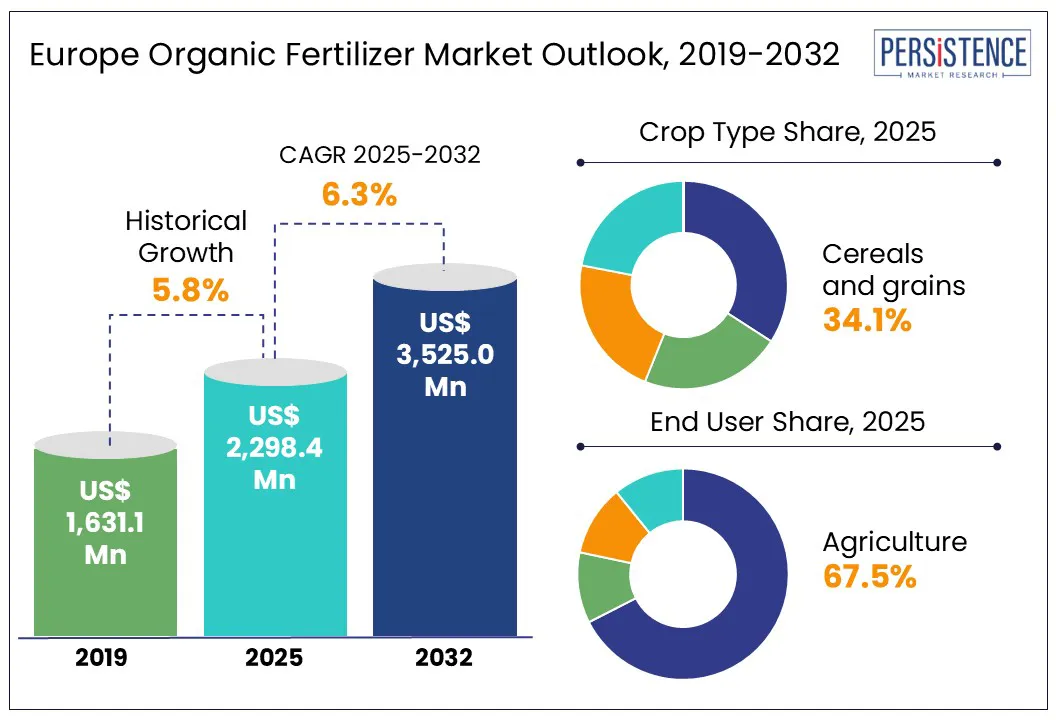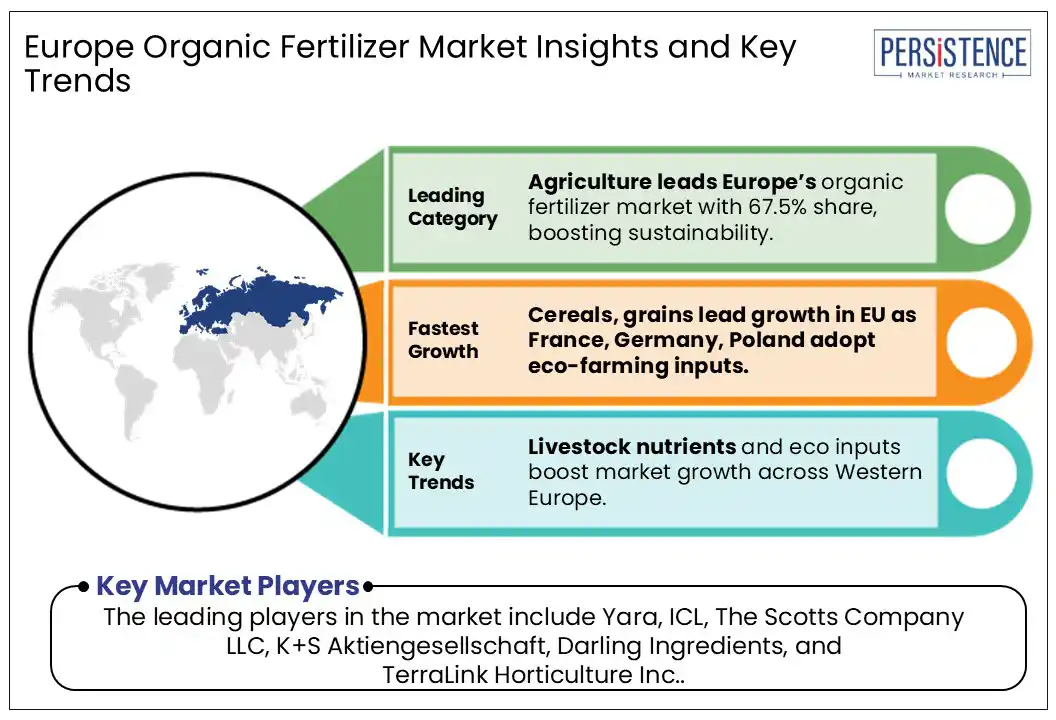ID: PMRREP34777| 179 Pages | 20 Jun 2025 | Format: PDF, Excel, PPT* | Chemicals and Materials

Europe organic fertilizer market size is likely to be valued at USD 2,298.4 Million in 2025 and is estimated to value at USD 3,525.0 Million by 2032, growing at a CAGR of 6.3% during the forecast period 2025 - 2032. Driven by the EU’s growing inclination toward natural soil nourishment and residue-free crops, this shift aligns with the data showing that 38.9 million hectares of farmable land in the region remain unfertilized. Among these, 30.6 million hectares are untreated grasslands, and 8.3 million hectares are idle or fallow. This underutilized land signals strong market potential for nature-based nutrient solutions, as EU farmers seek to enhance soil productivity without relying on chemicals.
Producers across Western and Eastern Europe face distinct cultivation patterns. While Western Europe allocates 25.7% of its fertilized area to grasslands and 12.6% to permanent crops such as vineyards and orchards, Central and Eastern Europe lean heavily on cereal and oilseed production, covering over 68% of fertilized lands. These variations demand adaptable crop inputs that align with regional soil and crop cycles. Farmers in both regions now increasingly opt for biologically enriched soil amendments to enhance nutrient absorption and crop resilience, especially in cereals (which alone cover over 53.5% of Eastern Europe’s fertilized land).

Key Industry Highlights:
|
Market Attribute |
Key Insights |
|
Europe Organic Fertilizer Market Size (2025E) |
US$ 2,298.4Mn |
|
Projected Market Value (2032F) |
US$ 3,525.0 Mn |
|
Market Growth Rate (CAGR 2025 to 2032) |
6.3% |
|
Historical Market Growth Rate (CAGR 2019 to 2024) |
5.8% |
Strong livestock presence and advanced nutrient recovery frameworks in Western Europe continue to drive steady demand for natural soil inputs. In 2023, farmers across the EU applied 8.3 million tons of nitrogen sourced from organic matter, nearly matching the 8.7 million tons drawn from mineral-based fertilizers. Potash use leaned even more toward biological origins, with 9.9 million tons applied compared to only 2.2 million tons from synthetic inputs. The EU-14 bloc alone delivered 6.7 million tons of organic nitrogen, 3.5 million tons of phosphate, and 7.9 million tons of potash, showing how established systems are driving sustainable nutrient cycles.
France, Germany, Spain, and the UK continue to dominate due to high livestock density and robust nutrient recovery. France surpassed 1800 kt in organic potash availability, while Germany recorded over 1200 kt of nitrogen, 900 kt of phosphate, and nearly 1500 kt of potash from livestock-derived sources. Spain and the UK each exceeded 1200 kt of potash, highlighting their strength in organic nutrient flows. In contrast, Latvia, Lithuania, and Estonia reported under 200 kt across nitrogen, phosphate, and potash, creating a stark gap that signals high-growth potential for compost-based and manure-enriched inputs across Eastern and Central Europe.
Europe’s stringent environmental goals, particularly those set by the Farm to Fork strategy, push for rapid reductions in nutrient losses. However, the aggressive timeline does not align with the practical capabilities of current farming methods. Achieving improved nutrient use efficiency demands significant changes, including precise nutrient management and on-farm fertilization innovations.
Farmers must adopt complex nutrient planning and invest in technology to meet these standards, which slows the transition to eco-friendly soil amendments. Without sufficient financial and technical support, many producers may struggle to fully integrate these greener alternatives into their routine practices.
Nutrient application trends across Europe between 2024 and 2034 reveal widening disparities, unlocking focused growth paths for bio-based fertilizer products. Cyprus and Greece ramped up nitrogen use by 30–40%, while Germany's phosphate consumption is projected to jump 80%. Potash demand across Western Europe climbed 22.3%, and phosphate use across the EU-27 increased 20.1%. These surges point to regions under intense nutrient pressure, where farmers increasingly turn to eco-compatible alternatives to protect soil health under continuous cropping cycles.
Countries such as Ireland, the Netherlands, and Croatia offer a very different picture with notable reductions in synthetic inputs. Ireland alone cut nitrogen use by 12.7%, phosphate by 16%, and potash as part of its shift toward regenerative practices. The Netherlands followed with a 10.7% nitrogen drop, while Croatia trimmed usage by 4.2%. These trends reveal clear entry points for compost-driven and animal-waste-derived nutrient solutions that meet regulatory shifts and sustainability demands. The dual push, intensifying nutrient load in some areas and green reforms in others, makes Europe a dynamic landscape for earth-friendly fertilizer innovation.
Farmers in Europe are intensifying crop production despite shrinking arable land, driving up nutrient needs sharply. Cereal yields are on track to increase by 3.9%, with maize yields surging 8.3% even as its cultivation area shrinks by 2.1%. Barley benefits from both expanded area (+1.3%) and improved yields (+4%), while other coarse grains balance a slight area drop (–0.4%) with a 3% yield boost. This shift toward more nutrient-demanding crops pushes nitrogen use higher, with phosphate demand jumping 27.6% in oilseeds and potash consumption rising 24.5% for sugar beet and 21.9% for potatoes.
Agriculture accounts for the large market share of 67.5% in 2025, for nature-based soil amendments, powered by the region’s vast and dynamic farming ecosystem. In 2024, agricultural output reached nearly USD 575 billion, with crop production alone contributing around USD 285 billion. The consistent growth in agricultural income (+1.9%) and a strong gross value added of USD 252.6 billion highlight how farmers are increasingly investing in solutions that sustain productivity while reducing dependence on chemicals. With cereals, vegetables, and horticulture leading the way, demand for clean, eco-safe nutrients continues to rise.
Millions of small farms spread across EU nations work as the backbone of the region’s food economy. These producers prioritize soil health to maintain output efficiency and long-term sustainability. For every euro spent on inputs, the agricultural sector generated €0.78 in added value a figure that reflects smarter input choices and increased interest in natural soil fortifiers. With agriculture contributing 1.3% to the EU’s GDP and functioning as the supply engine for food and beverage processing, the sector’s demand for earth-friendly crop nutrition remains central to its operational model.
Cereals and grains lead the crop-type segment in the European natural soil enhancer market, accounting for an estimated 34.1% share. This dominance stems from their vast cultivation footprint across countries such as France, Germany, and Poland. Despite weather-related production hurdles in regions like Spain and Denmark, consistent demand for sustainable inputs has made this segment a reliable driver of volume growth. As cereal production stabilizes post-drought, farmers continue to adopt bio-based alternatives to maintain soil fertility and long-term yield efficiency.
France alone contributed nearly one-fourth of the EU’s total cereal output in 2023, while Germany and Poland followed closely. These high-output zones have witnessed a notable uptick in regenerative agriculture practices, especially where crop rotation and minimal chemical dependency are key. The consistent replacement of synthetic options with eco-safe nutrients across cereal farms positions this segment for sustained growth, even as seasonal challenges remain a factor.

Germany held a dominant 18.9% share of the European market in 2024, driven by its structured focus on sustainable farming practices and increasing demand for eco-conscious inputs. The country witnessed a 1.6% rise in land under certified organic cultivation, touching 29,160 hectares. This expansion, though modest, reinforced demand for biological nutrients across cereals, dairy, and vegetable production zones. Germany’s organic milk production touched 1.4 million tons, reflecting not just volume but the growing shift toward naturally sustained livestock feed systems.
Revenues from organic food sales surged close to €17 billion, indicating strong consumer alignment with clean-label agricultural practices. This rising demand fuels a stable uptake of bio-based soil enhancers across farms. Despite trailing the national 2030 goal of having 30% of farmland organic, the country continues to scale adoption through regional subsidies and farmer incentives. Germany’s role as a technology-forward agricultural market further supports the expansion of biologically derived nutrient systems, making it a key player in setting regional trends.
Italy commands a 14.2% share in the European market, supported by its fast-expanding eco-agriculture sector. In 2024, the country recorded 2.46 million hectares under certified organic cultivation, a 4.5% jump over 2022. This accounts for nearly 20% of Italy’s total farmland, placing the country at the forefront of sustainable agricultural practices in Europe. The increase in certified land has fueled demand for soil enrichment products that support chemical-free farming and preserve long-term soil health.
The number of registered organic operators rose to 94,441, showing that small and mid-sized farms are increasingly aligning with green practices. This broad base of adoption strengthens local demand for crop nutrition inputs that meet EU environmental regulations. Italy’s legacy of quality food production, combined with its push for sustainability, continues to drive the transition toward natural cultivation methods. These factors firmly position the country as a key growth engine in the regional bio-based agricultural input market.
The Europe organic fertilizer market features a competitive landscape characterized by strategic mergers, acquisitions, and technological advancements as key growth drivers. Leading companies such as Yara International, Tessenderlo Group, IFFCO, Coromandel International, and ICL actively pursue acquisitions and partnerships to expand their organic fertilizer portfolios and regional presence. For example, Yara strengthened its position through acquisitions such as Ecolan Oy and Agribios Italiana and launched the YaraSuna line focusing on regenerative agriculture, reflecting a clear strategy to align with EU sustainability goals. Tessenderlo expanded production capabilities with new organic pellet lines, demonstrating investment in bio-valorization technology to improve fertilizer efficacy.
The market remains moderately fragmented but is moving toward consolidation as larger players leverage joint ventures and collaborations to innovate and access new markets. IFFCO’s launch of Nano DAP Liquid Fertilizer highlights technological innovation aimed at producing residue-free, eco-friendly products, while Coromandel’s state-of-the-art nano fertilizer plant signals adoption of next-gen nutrient solutions. These strategies underscore manufacturers’ focus on combining sustainable product development with regional expansion, addressing diverse soil and crop needs across Europe. Overall, the competitive landscape is shaped by a mix of organic growth and strategic alliances that enhance product portfolios and accelerate market penetration.
The European organic Fertilizer market is projected to be valued at US$ 2,298.4 million in 2025.
The Cereals and Grains segment is set to capture approximately 34.1% of the market in 2025, driven by its high demand in automotive tires and industrial applications.
The market is poised to witness a CAGR of 6.3% from 2025 to 2032.
Livestock-backed nutrient systems in Western Europe are boosting adoption, with over 8.3 million tons of nitrogen sourced from biological matter in 2023.
Diverging nutrient trends unlock niche markets, with Western nations increasing usage while others like Ireland and the Netherlands reduce synthetic dependency creating fertile ground for eco-safe inputs.
The top manufacturers include Yara, ICL, The Scotts Company LLC, K+S Aktiengesellschaft, Darling Ingredients, and TerraLink Horticulture Inc., are the leading participants in the Europe organic fertilizer market.
|
Report Attribute |
Details |
|
Forecast Period |
2025 to 2032 |
|
Historical Data Available for |
2019 to 2024 |
|
Market Analysis |
US$ Mn for Value, Tons for Volume |
|
Key Countries Covered |
|
|
Key Market Segments Covered |
|
|
Key Companies Profiled in the Report |
|
|
Report Coverage |
|
|
Customization & Pricing |
Available upon request |
By Source
By Crop Type
By Form
By End-use
By Region
Delivery Timelines
For more information on this report and its delivery timelines please get in touch with our sales team.
About Author